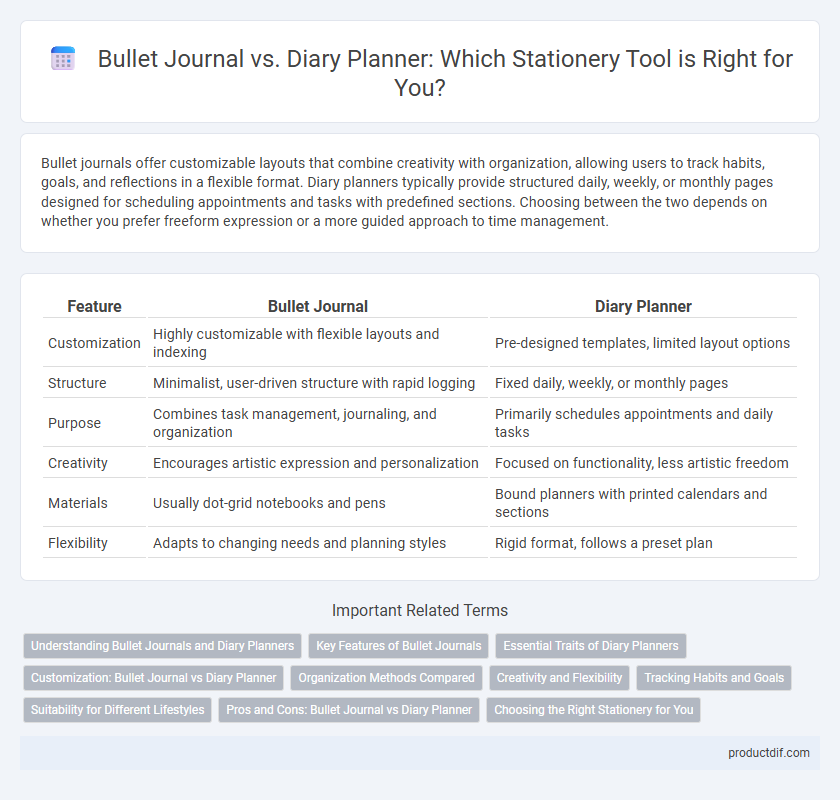Bullet journals offer customizable layouts that combine creativity with organization, allowing users to track habits, goals, and reflections in a flexible format. Diary planners typically provide structured daily, weekly, or monthly pages designed for scheduling appointments and tasks with predefined sections. Choosing between the two depends on whether you prefer freeform expression or a more guided approach to time management.
Table of Comparison
| Feature | Bullet Journal | Diary Planner |
|---|---|---|
| Customization | Highly customizable with flexible layouts and indexing | Pre-designed templates, limited layout options |
| Structure | Minimalist, user-driven structure with rapid logging | Fixed daily, weekly, or monthly pages |
| Purpose | Combines task management, journaling, and organization | Primarily schedules appointments and daily tasks |
| Creativity | Encourages artistic expression and personalization | Focused on functionality, less artistic freedom |
| Materials | Usually dot-grid notebooks and pens | Bound planners with printed calendars and sections |
| Flexibility | Adapts to changing needs and planning styles | Rigid format, follows a preset plan |
Understanding Bullet Journals and Diary Planners
Bullet journals combine task lists, calendars, and notes into a customizable system using rapid logging with symbols to track tasks, events, and thoughts. Diary planners typically use pre-printed dated pages structured for daily, weekly, or monthly planning and often include sections for appointments and personal reflections. Understanding these differences helps users choose between the flexible, creative layout of bullet journals and the organized, preset format of diary planners.
Key Features of Bullet Journals
Bullet journals are highly customizable organizational tools featuring dot-grid pages that allow users to combine task lists, calendars, habit trackers, and notes in a single notebook. Key features include rapid logging with bullets, migration of tasks to prioritize unfinished items, and flexibility in design to adapt to personal productivity styles. This system enhances mindfulness and efficiency by encouraging reflection and daily planning tailored to individual needs.
Essential Traits of Diary Planners
Diary planners emphasize organized scheduling with date-specific entries, enabling precise daily, weekly, and monthly planning. They typically feature pre-printed calendars, time slots, and designated sections for appointments, tasks, and priorities. This structure enhances time management and goal tracking, distinguishing diary planners from the more flexible, customizable layouts of bullet journals.
Customization: Bullet Journal vs Diary Planner
Bullet journals offer extensive customization through personalized layouts, flexible formats, and creative design options, allowing users to tailor their planning system to specific needs and preferences. Diary planners typically provide structured templates with limited customization, prioritizing standardized organization and ease of use. Users seeking adaptability and creative freedom often prefer bullet journals, while those desiring consistency and simplicity lean toward diary planners.
Organization Methods Compared
Bullet journals utilize rapid logging with customizable symbols and layouts to track tasks, events, and notes in a flexible format that adapts to individual needs. Diary planners rely on pre-structured daily or weekly templates to organize schedules and appointments, offering a more traditional, time-specific approach. Both methods enhance productivity, but bullet journals prioritize creative organization and task migration, while diary planners emphasize chronological planning and routine consistency.
Creativity and Flexibility
Bullet journals offer unmatched creativity by allowing users to customize layouts, combine artistic elements, and incorporate diverse content like habit trackers and mood logs. Diary planners provide structured flexibility with predefined sections for scheduling and goal-setting, streamlining organization while still accommodating personal notes. Both stationery tools cater to different needs, making bullet journals ideal for creative expression and diary planners for systematic time management.
Tracking Habits and Goals
Bullet journals offer flexible habit and goal tracking through customizable spreads that adapt to individual needs, while diary planners provide structured templates with predefined sections for daily, weekly, or monthly tracking. Habit trackers in bullet journals encourage creativity by allowing users to design personalized grids or charts that enhance motivation and accountability. Diary planners streamline goal management using consistent formats that facilitate routine monitoring and progress evaluation.
Suitability for Different Lifestyles
Bullet journals offer unparalleled customization, making them ideal for creative individuals and those with fluctuating schedules seeking flexibility and personalization. Diary planners provide structured layouts that suit professionals and routine-oriented users who prefer predefined time slots and organized daily entries. Selecting between a bullet journal and a diary planner depends on lifestyle needs, with bullet journals fitting dynamic, artistic lifestyles and diary planners meeting the demands of regimented, goal-driven routines.
Pros and Cons: Bullet Journal vs Diary Planner
Bullet Journal offers customizable layouts and flexibility, allowing users to track habits, plan tasks, and express creativity but may require more time and effort for setup and maintenance. Diary Planners provide structured daily, weekly, or monthly templates that simplify organization and time management, though they can limit personalization and adaptability to changing needs. Choosing between the two depends on whether an individual values creative freedom and detailed tracking or prefers straightforward, pre-designed planning formats.
Choosing the Right Stationery for You
Selecting the right stationery between a bullet journal and a diary planner depends on your organizational style and creativity level. Bullet journals offer customizable layouts ideal for tracking goals, habits, and personal projects, while diary planners provide structured schedules and dated pages for daily appointments and deadlines. Consider factors like flexibility, design preferences, and the purpose of your planning to optimize productivity and maintain motivation.
Bullet Journal vs Diary Planner Infographic

 productdif.com
productdif.com